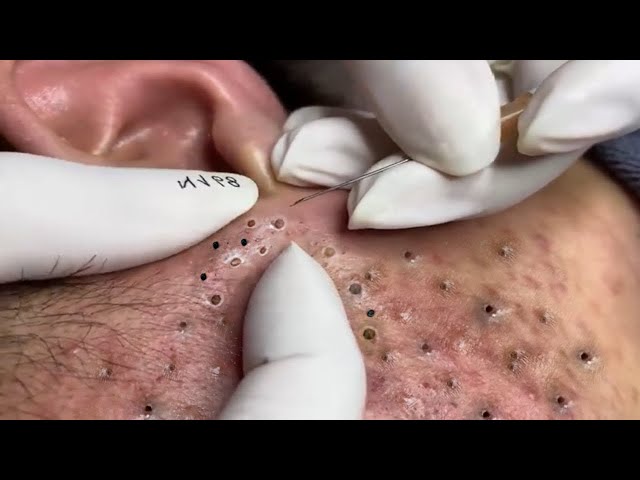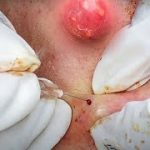✅ Step-by-Step Treatment for a Big Blackhead
1. Cleanse the Skin
-
Use a gentle cleanser to remove dirt, oil, and makeup.
-
Warm water helps open pores slightly.
2. Steam the Area (Optional but Helpful)
-
Apply a warm towel or use facial steam for 5–10 minutes to soften the skin and loosen the blackhead.
-
This makes extraction easier and safer.
3. Use a Blackhead Removal Tool (Comedone Extractor)
-
Disinfect the tool with rubbing alcohol first.
-
Gently press the loop around the blackhead. If it doesn’t come out easily, do not force it — forcing can cause scarring or infection.
4. Apply a Clay Mask or Salicylic Acid Product
-
Clay masks help draw out excess oil and tighten pores.
-
Salicylic acid helps dissolve oil inside the pores and prevent future blackheads.
5. Soothe the Skin
-
Apply a toner (preferably alcohol-free) and then a soothing, non-comedogenic moisturizer.
⚠️ What to Avoid
-
Don’t squeeze with nails or fingers. It can cause scarring or push bacteria deeper.
-
Avoid harsh scrubs—they can irritate the skin and worsen acne.
🧴 Products That Help Prevent Blackheads
-
Salicylic acid (2%) – unclogs pores.
-
Retinoids (like adapalene) – reduce comedones and promote skin turnover.
-
Niacinamide – controls oil and calms inflammation.
-
Clay masks – use 1–2x/week for oily areas.
🧑⚕️ When to See a Dermatologist
-
If the blackhead is very deep, painful, or not coming out easily.
-
For frequent or cystic acne.
-
For professional extraction or prescription treatments.
Treating a large blackhead effectively and safely requires a combination of proper skincare, appropriate tools, and sometimes professional intervention. Here’s a detailed guide based on expert recommendations:
🧼 Step-by-Step Guide to Safe Blackhead Removal
1. Cleanse Your Skin
-
Use a gentle, non-comedogenic cleanser to remove dirt, oil, and makeup.
-
Avoid harsh scrubs, as they can irritate the skin and worsen acne.
2. Soften the Skin
-
Apply a warm compress or use facial steam for 5–10 minutes to open pores and soften the blackhead.
-
This step makes extraction easier and reduces the risk of skin damage.
3. Use a Comedone Extractor Tool (Optional)
-
Disinfect the tool with rubbing alcohol before use.
-
Gently press the loop around the blackhead. If it doesn’t come out easily, do not force it.
-
Avoid using the pointed end of the tool, as improper use can cause skin damage.
4. Apply a Clay Mask or Salicylic Acid Product
-
Clay masks help draw out excess oil and tighten pores.
-
Salicylic acid helps dissolve oil inside the pores and prevent future blackheads.
5. Soothe the Skin
-
Apply a toner (preferably alcohol-free) and then a soothing, non-comedogenic moisturizer.
-
Avoid using alcohol or acid-based facial products for up to 24 hours after extraction.
⚠️ Risks of At-Home Extraction
-
Improper use of extraction tools can lead to pain, redness, infection, and scarring.
-
Squeezing or pinching blackheads can irritate the skin and push bacteria deeper, worsening the condition.
-
It’s challenging to achieve the same level of sterilization at home as professionals can provide, increasing the risk of infections.
🧴 Recommended Products
-
Salicylic Acid (2%): Unclogs pores and reduces oil.
-
Retinoids (e.g., Adapalene): Promote skin turnover and prevent blackheads.
-
Niacinamide: Controls oil and calms inflammation.
-
Clay Masks: Use 1–2 times a week for oily areas.
🧑⚕️ When to Consult a Dermatologist
-
If the blackhead is very deep, painful, or not coming out easily.
-
For frequent or cystic acne.
-
For professional extraction or prescription treatments.
To effectively treat and remove a large blackhead, follow this detailed protocol that combines immediate removal techniques with ongoing treatment solutions to prevent recurrence. Here’s how to do it, step by step, with scientifically-backed options:
✅ How to Remove a Big Blackhead Safely
🔹 Step 1: Prepare the Skin
Purpose: Soften the skin and open pores.
-
Cleanser: Use a gentle facial cleanser with salicylic acid (2%) (e.g., CeraVe Renewing SA Cleanser).
-
Steam or warm compress:
-
Apply a warm towel or use steam for 5–10 minutes.
-
This loosens the blackhead by softening the plug of oil and dead skin.
-
🔬 Salicylic acid is a beta-hydroxy acid that penetrates oil and dissolves pore blockages.
🔹 Step 2: Extract (Optional but Cautious)
Purpose: Manual removal if the blackhead is close to the surface.
-
Use a sterile comedone extractor tool:
-
Disinfect the tool with isopropyl alcohol.
-
Gently press around the blackhead; if it doesn’t come out easily, stop.
-
-
OR: Use pimple patches with hydrocolloid + salicylic acid to draw it out overnight (e.g., COSRX Pimple Patches).
⚠️ Avoid using fingers or nails to squeeze — this can lead to infection or scarring.
— Medical News Today
🔹 Step 3: Post-Treatment Care
Purpose: Soothe and disinfect the area.
-
Apply a toner with witch hazel or niacinamide (e.g., The Ordinary Niacinamide 10% + Zinc 1%).
-
Use a non-comedogenic moisturizer (e.g., La Roche-Posay Toleriane).
🧴 Long-Term Treatment Plan: Prevention & Maintenance
| Product Type | Ingredient | Effect |
|---|---|---|
| Exfoliant | Salicylic Acid 2% | Dissolves debris in pores |
| Topical Retinoid | Adapalene (e.g., Differin Gel) | Promotes skin turnover, prevents clogging |
| Oil Control | Niacinamide | Reduces sebum production |
| Clay Mask | Kaolin/Bentonite | Absorbs oil and tightens pores |
🗓 Routine:
-
Morning: Gentle cleanser → Niacinamide serum → Moisturizer → Sunscreen
-
Night: Salicylic acid (or Adapalene) → Moisturizer
-
Weekly: Clay mask (1–2x/week)
💡 Retinoids like adapalene are clinically proven to reduce comedonal acne by increasing skin cell turnover.
— American Academy of Dermatology
🧑⚕️ When to See a Dermatologist
-
Recurrent large or cystic blackheads
-
Scarring or persistent acne
-
You want prescription-strength retinoids (e.g., Tretinoin)


